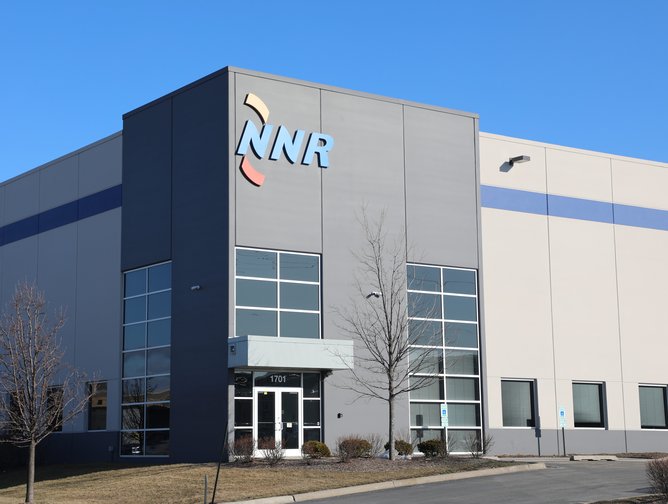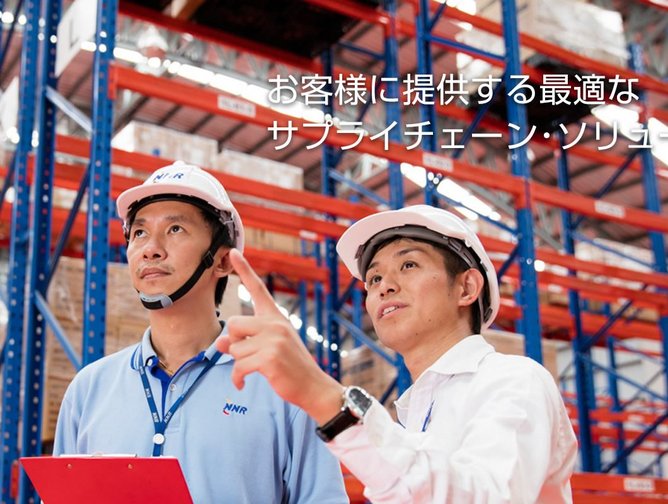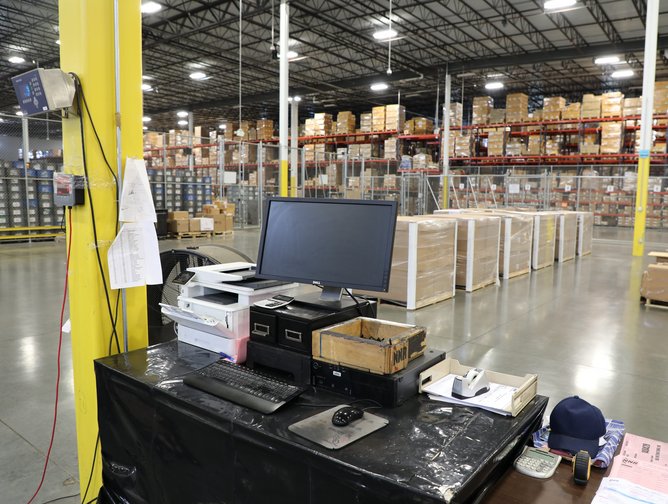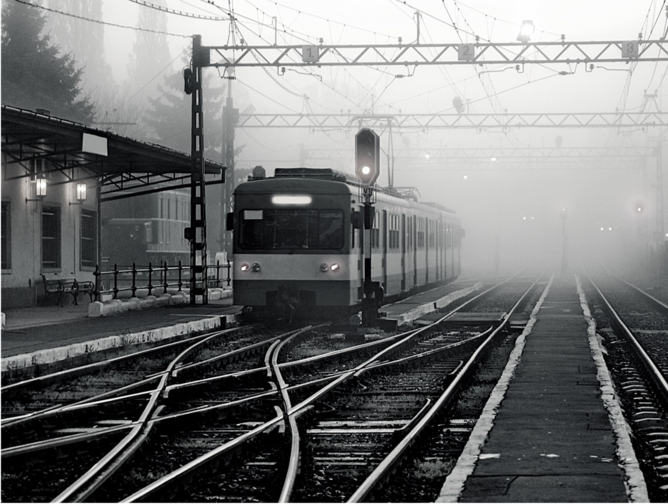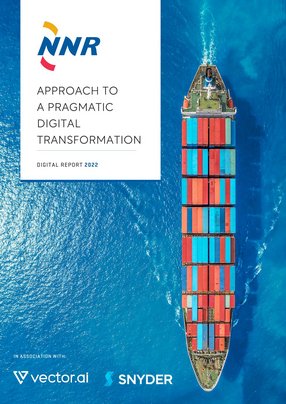When we think about logistics, when we picture the oceans being crisscrossed by thousands of gargantuan cargo ships with their huge multicoloured containers stacked sky-high; when we picture the multitudes of blimp-like cargo planes that saturate the stratospheres with their freight-in-tonnage; the land, the sea, the skies – we doubtless take it to be the very paradigm of efficient processes. It must be, surely?
With the entire business world – indeed, the entire human world – depending on its arterial and vascular traffic (‘vessels’ being named so for a reason), it must be the case that until now efficiency has been at the very pulse and feedback of this entire system.
Admittedly, then, it was a surprise to discover that this has categorically not been the case for central aspects of logistics or the supply chain as a whole, both in the past and in most cases, even the present.
Mac Sullivan, Head of Technology and Digital Promotion at NNR Global Logistics (USA), is the man who supplied this rude awakening. “I have cargo that I need to send from Dallas to London. In order to figure out all the different ways that I can get it there, all the relevant contracts as well as all the potentially different routes have to be centralised to a specific location. What we've found is that logistics as a whole, has been way, way behind in its modus operandi. A great number of logistics companies have up until now, been working with paper-based, (literally ‘written-down’) information. This goes all the way through from the tracking of orders to the recording of sales receipts and information,” he says.
This must be a mistake of some kind – we have our eyes on Mars; we are on the forefront of quantum computation and have systems in AI and big data that are so sophisticated that, schematically at least, they know more about us than we do about ourselves. “Way, way behind.”
“If data isn't entered into a digital system, you simply don't have ‘visibility,’ which means that you don't have all the pieces to the logistical puzzle,” he says. This sounds like a crash-course in how not to run the global supply chain.
The ability to digitise elements of the supply chain and more specifically, the logistics chain, helps provide greater visibility to potential solutions. In a globalised world, the use of paper is tantamount to the obfuscation of processes, whereas the digitalisation of data is equal to their elucidation. If supply chain is the realm, data is king.
Once elucidated through digitalisation, the data of course needs to be sifted-through and sorted – in a sort of vast problem-solving operation, and this is where Artificial Intelligence ‘traditionally’ comes in. But here again, in supply-chain terms, we have been labouring under the misconception that, until now, AI has been doing its god-like work of solving all such humanly insurmountable problems in an algorithmic whizz, so that we can rest easy that our supplies will be efficiently delivered and that no complications will arise. But Sullivan says, “the truth is that independently, AI still hasn't been able to solve the problems that we actually have.”
So, the schema goes: AI needs human intervention, and humans need to digitise their data in order that AI can then provide our goods through the supply chain and help us to breathe easy.
But then, in a much-needed cause for exhale, he provides respite to this unacceptable state of affairs: “This is however, finally starting to change,” he says. “The technology and the availability of data that allows us to present the problems to AI - so that it can begin to solve those problems - is now at our fingertips. It’s a really exciting time in the logistics industry, because through the digitisation of data, we are starting to make solutions more readily available. But it will then be – contrary to popular opinion – about the further narrowing-down of those AI solutions through a human agent, enabling us to start assigning the technology to then solve the important issues.”
The exposition is interesting. Sullivan, while teaching Business English at university-level in Shanghai, met his present boss Jeff McDonald, who then introduced him to the world of international logistics. “I hit the ground running, with zero background in international business, and started learning how to move freight around the world,” says Sullivan – and he has come a long way since.
The issue of technological disruption for supply chain and logistics is one that he has been turning over in his mind for some time now.
“Many years ago, I began looking at logistics and the lack of technological adoption in this industry in the broadest sense. I started reading a lot on the subject, doing some of my Master's level work on this topic and then started my PhD work again (which was then on hold) on the thesis of how technology could disrupt the entire international logistics industry. That was in 2016. So then, with this insight, I aimed to get out of the commercial world of logistics and into the technology side of things,” he says.
Now Head of Technology and Digital Promotion at NNR, Sullivan’s role involves running a now 41 headcount team that is broken up into four sub-teams. “Firstly, we have EDI (Electronic Data Interchange) and API teams, together making up 'connectivity', which deals with connecting with our vendors, customers, and agents. Secondly, we have a product development and maintenance team for our homegrown global ERP. Third, we have two smaller programmes, one called NNR Connect, which is our new showcase product, and then a homegrown CRM system. We then have traditional IT, hardware, networking, cybersecurity, etc that falls into another (fourth) bucket.”
Of these, NNR Connect deserves a place in the spotlight. NNR Connect is a customer-facing portal that uses AI and cloud tech where customers can easily book, pay for, and track in real-time all their shipments through a truly frictionless, intuitive interface. This is where tech and data intersect to fulfil NNR Global’s vision of a streamlined, customer-focused logistics experience.
NNR’s corporate slogan is 'connecting your dreams', which means providing comfort, confidence and enjoyment for their customers, “and that means that your cargo is getting to the right place, at the right time and at the right cost,” says Sullivan.
NNR’s digitisation in the logistics industry
On the conceptual issue of digitalisation in the logistics industry, Sullivan says: “I wrote a book on the subject that was subtitled: Demystifying Impacts of the Fourth Industrial Revolution, where we brought together a group of 27 authors from around the world, from different segments of the logistics industry, and gave them this broad theme, ranging from blockchain to 3D printing to digital platforms and rate management. We tried to drive home the idea of a pragmatic framework, so it’s neither your consultant's version, nor is it your academic version of digital transformation. It is a kind of ‘where top-down meets bottom-up’ approach – that is, right in the middle. It is about looking at big problems, while also solving them for the desk-level users.’
When asked what Digital Transformation means for NNR Global, Sullivan answers with a single word: tracking. He then unfolds this idea: “If you go on Amazon, you can order a $2 mug. It will show up at your door, either two hours or two days later, but with turn-by-turn instructions and information on where it is along the way. ‘It's left the warehouse’; ‘it's nearing your location’; ‘it's been delivered’. That visibility has not been found in the business logistics industry, even though the cargo could be worth upwards of $2 million. So, tracking and shipment visibility is now a big push, and that is where a lot of people are spending their money, because that’s where the demand is – and that’s why we developed NNR Connect.”
Global shifts and rate-management through tech
With global occurrences such as the obvious 2020 pandemic and its initially not-so-obvious supply-chain consequences, the US-China trade war and Russia’s invasion of Ukraine, price fluctuations are at truly unstable levels. NNR has about 15 to 30 different ocean carriers, about 50 to 100 different air-carriers and about 2000 to 5000 different trucking carriers that they work with.
Sullivan says: “We make contracts with all these different carriers, trying to aggregate and then filter-through all the related contracts in order to find the right rates, for the right type of shipment, with the right validity. This is why Amazon has made so much money – applying the right filters in the right places.”
“Rate-management has really come down in price, in that the filters and the technology have been able to aggregate all that data, add some basic AI in terms of scraping through the different documents as they come in, and then centralising them. But post-2019, because there is so much fluctuation in price due to the inconsistencies in supply and demand, you can throw all of that out of the window. We are finding ourselves in a situation where we must pick up the phone and say, 'hey, what rate can you give me for this car, right now?', which has really made the environment a lot more competitive again – where it's not just all about big-buy. Now, it's all about local relationships and about picking up the phone and working hard to get it done.”
How technology is utilised for sourcing
On the question of utilising technology for sourcing, Sullivan also expresses how large companies are having a transformational impact. “Alibaba, for example, has changed the face of globalisation by making products in mass quantities available through their site. On the consumer side, between Alibaba and China, Amazon, and the US, and also on a global scale, we're starting to see how you can now track demand.
“Another example would be Jungle Scouts, a SaaS company that helps facilitate the sourcing of different product categories, where Amazon FBA sellers can go and find products that are undersold and under-priced, which will then help them to actually go upstream to the very sources of those products.”
NNR's customer facing portal
In 2019 NNR were faced with deciding on whether to update their old customer facing portal, or to completely rebuild it. “We decided to start from scratch,” he says, “and to rebuild it from the ground up. We brought in a very young, aesthetically driven team to bring a product to market that is completely unique. We have handcrafted every button, every component, every page, and colour scheme, and we were able to do this with a fairly limited number of resources. We’re rolling out different modules as we speak and have already rolled out our shipment module, our billing module and so on. Our accounting team said, 'we need our customers to be able to pay via credit card', so we reached out to different vendors and put together a smooth, user-friendly, frictionless customer-experience, where our customers can easily go and pay their invoices. We're releasing some pretty exciting stuff that relates to the partnership we have with vector AI, in terms of seriously starting to eliminate any redundant manual entry upstream and have many upcoming releases in the pipeline.”
NNR partner ecosystem
This partnership with Vector AI has been an important one for NNR. OCR technology has been used by big banks and big insurance companies for about two decades. But you had to have millions of remarkably similar documents that were being processed to be able to extract those different data elements to utilise, and so the cost was prohibitively high.
Sullivan says: “Even when I started looking at this just five years ago, you still couldn't get a solid pilot with any OCR company without a significant initial investment. Vector AI came along with a strong recommendation, led by logisticians, and co-led by technologists – it was the right company at the right time. What we've been working on with them is outside of their traditional service offering, as it's about going upstream and looking at what documents our customers can provide there, so that we can extract the data from those documents, pre-populate what we need in order to process the shipments, and then recanalize that information to flow downstream. So, we're aggressively partnering with Vector AI to go way upstream and extract the more difficult information from many different customers in many different formats.
“With NNR Connect, we're about to roll-out our vector co-designed product called Quick Book. They're also working with our accounting team on the more traditional avenue of getting better invoices via email, extracting the information, and then helping to facilitate that automation of accounts payable.”
Another key partner for NNR is Snyder Technology. “Snyder has been with me since day one in this role,” says Sullivan. “Ben Snyder, the CEO, is somebody that I was introduced to by a friend of mine, also in the logistics and technology space. They have helped us move 100% to the cloud, as well as to rapidly accelerate our adoption onto Microsoft's 365 platform. They are developing NNR Connect – the customer facing portal – alongside us, as well as doing everything from data recovery to API integrations with vendors. It's a broad partnership in terms of digital transformation, product development, infrastructure and they are our licensed Microsoft CSP.”
What do the next 12 to 18 months look like for NNR?
The next 12 to 18 months are going to continue to be dynamic for NNR. They are aiming to take on their technical debt through a massive database consolidation, aiming to go from the 52 databases that they either control or deal with on a day-to-day basis and instead reduce that number down to 12 to 15.
Sullivan says: “That's a big effort to reduce our technical debt, to make sure we're going to the new age with less baggage. We're going to be quickly expanding our offering through NNR Connect and rolling that out to our office and global customers. We're also looking to rapidly improve our connectivity speed and efficacy, bring on new vendors and customers, and connect to them electronically at a much faster.
